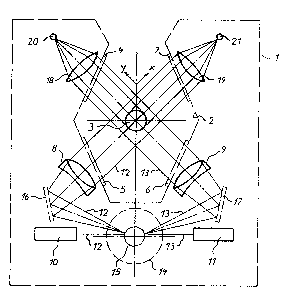Une partie des informations de ce site Web a été fournie par des sources externes. Le gouvernement du Canada n'assume aucune responsabilité concernant la précision, l'actualité ou la fiabilité des informations fournies par les sources externes. Les utilisateurs qui désirent employer cette information devraient consulter directement la source des informations. Le contenu fourni par les sources externes n'est pas assujetti aux exigences sur les langues officielles, la protection des renseignements personnels et l'accessibilité.
L'apparition de différences dans le texte et l'image des Revendications et de l'Abrégé dépend du moment auquel le document est publié. Les textes des Revendications et de l'Abrégé sont affichés :
| (12) Brevet: | (11) CA 2093551 |
|---|---|
| (54) Titre français: | METHODE ET APPAREIL POUR MESURER LES DIMENSIONS D'UN OBJET |
| (54) Titre anglais: | METHOD AND APPARATUS FOR MEASURING THE DIMENSIONS OF AN OBJECT |
| Statut: | Périmé et au-delà du délai pour l’annulation |
| (51) Classification internationale des brevets (CIB): |
|
|---|---|
| (72) Inventeurs : |
|
| (73) Titulaires : |
|
| (71) Demandeurs : |
|
| (74) Agent: | NORTON ROSE FULBRIGHT CANADA LLP/S.E.N.C.R.L., S.R.L. |
| (74) Co-agent: | |
| (45) Délivré: | 2004-08-24 |
| (22) Date de dépôt: | 1993-04-06 |
| (41) Mise à la disponibilité du public: | 1993-10-11 |
| Requête d'examen: | 2000-03-15 |
| Licence disponible: | S.O. |
| Cédé au domaine public: | S.O. |
| (25) Langue des documents déposés: | Anglais |
| Traité de coopération en matière de brevets (PCT): | Non |
|---|
| (30) Données de priorité de la demande: | ||||||
|---|---|---|---|---|---|---|
|
Laser beams from separate sources are deflected by a
rotating mirror and travel over further mirrors and objective
lenses into a measuring field for measuring the dimensions of
an object 3 in the x and y directions. The result is a
simple, compact configuration. The separate optical systems
for both measuring directions can be set in an optimum manner
independently of one another, permitting great precision.
Thanks to an offset of the optical axis of the incident laser
beams relative to the rotation axis of the mirror the
measurements in the two directions are made staggered in time
so that the measurement signals can be processed in a common
measuring channel.
Note : Les revendications sont présentées dans la langue officielle dans laquelle elles ont été soumises.
Note : Les descriptions sont présentées dans la langue officielle dans laquelle elles ont été soumises.

2024-08-01 : Dans le cadre de la transition vers les Brevets de nouvelle génération (BNG), la base de données sur les brevets canadiens (BDBC) contient désormais un Historique d'événement plus détaillé, qui reproduit le Journal des événements de notre nouvelle solution interne.
Veuillez noter que les événements débutant par « Inactive : » se réfèrent à des événements qui ne sont plus utilisés dans notre nouvelle solution interne.
Pour une meilleure compréhension de l'état de la demande ou brevet qui figure sur cette page, la rubrique Mise en garde , et les descriptions de Brevet , Historique d'événement , Taxes périodiques et Historique des paiements devraient être consultées.
| Description | Date |
|---|---|
| Le délai pour l'annulation est expiré | 2009-04-06 |
| Lettre envoyée | 2008-04-07 |
| Inactive : CIB de MCD | 2006-03-11 |
| Inactive : CIB de MCD | 2006-03-11 |
| Accordé par délivrance | 2004-08-24 |
| Inactive : Page couverture publiée | 2004-08-23 |
| Préoctroi | 2004-06-10 |
| Inactive : Taxe finale reçue | 2004-06-10 |
| Un avis d'acceptation est envoyé | 2004-04-28 |
| Un avis d'acceptation est envoyé | 2004-04-28 |
| Lettre envoyée | 2004-04-28 |
| Inactive : Approuvée aux fins d'acceptation (AFA) | 2004-04-19 |
| Modification reçue - modification volontaire | 2003-12-17 |
| Inactive : Dem. de l'examinateur par.30(2) Règles | 2003-06-18 |
| Inactive : Dem. traitée sur TS dès date d'ent. journal | 2000-03-29 |
| Lettre envoyée | 2000-03-29 |
| Inactive : Renseign. sur l'état - Complets dès date d'ent. journ. | 2000-03-29 |
| Toutes les exigences pour l'examen - jugée conforme | 2000-03-15 |
| Exigences pour une requête d'examen - jugée conforme | 2000-03-15 |
| Demande publiée (accessible au public) | 1993-10-11 |
Il n'y a pas d'historique d'abandonnement
Le dernier paiement a été reçu le 2004-03-05
Avis : Si le paiement en totalité n'a pas été reçu au plus tard à la date indiquée, une taxe supplémentaire peut être imposée, soit une des taxes suivantes :
Veuillez vous référer à la page web des taxes sur les brevets de l'OPIC pour voir tous les montants actuels des taxes.
| Type de taxes | Anniversaire | Échéance | Date payée |
|---|---|---|---|
| TM (demande, 5e anniv.) - générale | 05 | 1998-04-06 | 1998-03-23 |
| TM (demande, 6e anniv.) - générale | 06 | 1999-04-06 | 1999-03-17 |
| Requête d'examen - générale | 2000-03-15 | ||
| TM (demande, 7e anniv.) - générale | 07 | 2000-04-06 | 2000-03-22 |
| TM (demande, 8e anniv.) - générale | 08 | 2001-04-06 | 2001-04-03 |
| TM (demande, 9e anniv.) - générale | 09 | 2002-04-08 | 2002-03-25 |
| TM (demande, 10e anniv.) - générale | 10 | 2003-04-07 | 2003-03-05 |
| TM (demande, 11e anniv.) - générale | 11 | 2004-04-06 | 2004-03-05 |
| Taxe finale - générale | 2004-06-10 | ||
| TM (brevet, 12e anniv.) - générale | 2005-04-06 | 2005-03-14 | |
| TM (brevet, 13e anniv.) - générale | 2006-04-06 | 2006-03-14 | |
| TM (brevet, 14e anniv.) - générale | 2007-04-10 | 2007-03-21 |
Les titulaires actuels et antérieures au dossier sont affichés en ordre alphabétique.
| Titulaires actuels au dossier |
|---|
| ZUMBACH ELECTRONIC AG |
| Titulaires antérieures au dossier |
|---|
| BEDA KASER |